Business and the Business Environment Analysis: Aston Martin Report
VerifiedAdded on 2022/12/30
|20
|6191
|83
Report
AI Summary
This report provides a comprehensive analysis of Aston Martin's business environment. It begins by defining different organizational types (private, public, and voluntary sectors) and their purposes, along with the size and scope of Aston Martin, BBC, and the David Suzuki Foundation. The report then explores the relationship between organizational functions and objectives, evaluating the benefits and drawbacks of their interrelationships. It includes a PESTLE analysis of the macro environment and a SWOT analysis to identify strengths, weaknesses, opportunities, and threats. The analysis considers how these factors influence business objectives and decision-making, providing a detailed overview of the external and internal factors that impact Aston Martin's operations and strategic planning, drawing on examples to illustrate the concepts.

Business and the Business
Environment
Environment
Paraphrase This Document
Need a fresh take? Get an instant paraphrase of this document with our AI Paraphraser
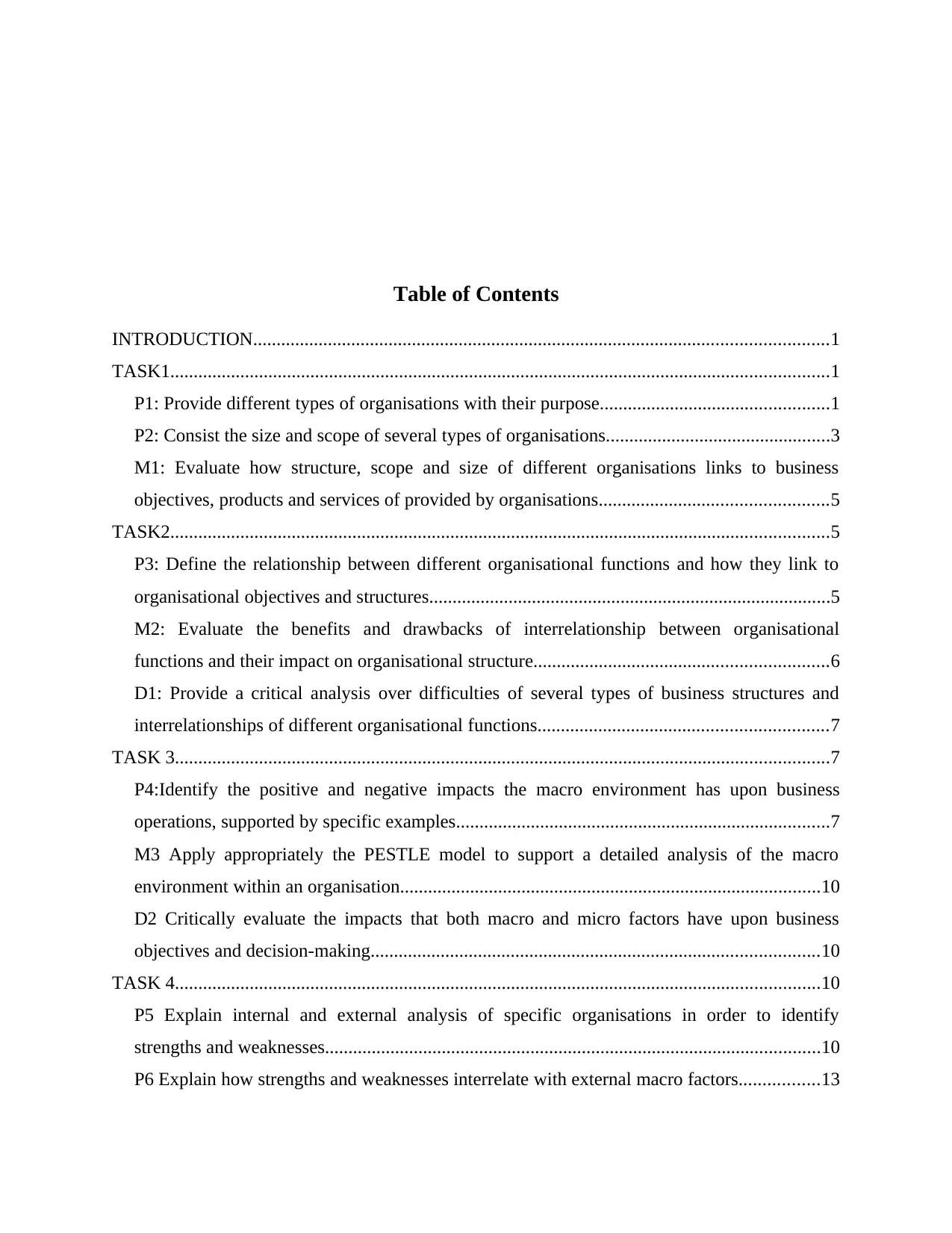
Table of Contents
INTRODUCTION...........................................................................................................................1
TASK1.............................................................................................................................................1
P1: Provide different types of organisations with their purpose.................................................1
P2: Consist the size and scope of several types of organisations................................................3
M1: Evaluate how structure, scope and size of different organisations links to business
objectives, products and services of provided by organisations.................................................5
TASK2.............................................................................................................................................5
P3: Define the relationship between different organisational functions and how they link to
organisational objectives and structures......................................................................................5
M2: Evaluate the benefits and drawbacks of interrelationship between organisational
functions and their impact on organisational structure...............................................................6
D1: Provide a critical analysis over difficulties of several types of business structures and
interrelationships of different organisational functions..............................................................7
TASK 3............................................................................................................................................7
P4:Identify the positive and negative impacts the macro environment has upon business
operations, supported by specific examples................................................................................7
M3 Apply appropriately the PESTLE model to support a detailed analysis of the macro
environment within an organisation..........................................................................................10
D2 Critically evaluate the impacts that both macro and micro factors have upon business
objectives and decision-making................................................................................................10
TASK 4..........................................................................................................................................10
P5 Explain internal and external analysis of specific organisations in order to identify
strengths and weaknesses..........................................................................................................10
P6 Explain how strengths and weaknesses interrelate with external macro factors.................13
INTRODUCTION...........................................................................................................................1
TASK1.............................................................................................................................................1
P1: Provide different types of organisations with their purpose.................................................1
P2: Consist the size and scope of several types of organisations................................................3
M1: Evaluate how structure, scope and size of different organisations links to business
objectives, products and services of provided by organisations.................................................5
TASK2.............................................................................................................................................5
P3: Define the relationship between different organisational functions and how they link to
organisational objectives and structures......................................................................................5
M2: Evaluate the benefits and drawbacks of interrelationship between organisational
functions and their impact on organisational structure...............................................................6
D1: Provide a critical analysis over difficulties of several types of business structures and
interrelationships of different organisational functions..............................................................7
TASK 3............................................................................................................................................7
P4:Identify the positive and negative impacts the macro environment has upon business
operations, supported by specific examples................................................................................7
M3 Apply appropriately the PESTLE model to support a detailed analysis of the macro
environment within an organisation..........................................................................................10
D2 Critically evaluate the impacts that both macro and micro factors have upon business
objectives and decision-making................................................................................................10
TASK 4..........................................................................................................................................10
P5 Explain internal and external analysis of specific organisations in order to identify
strengths and weaknesses..........................................................................................................10
P6 Explain how strengths and weaknesses interrelate with external macro factors.................13

M4 Apply appropriately SWOT analysis and justify how they influence decision making.....14
CONCLUSION............................................................................................................................15
REFERENCES..............................................................................................................................16
CONCLUSION............................................................................................................................15
REFERENCES..............................................................................................................................16
⊘ This is a preview!⊘
Do you want full access?
Subscribe today to unlock all pages.

Trusted by 1+ million students worldwide
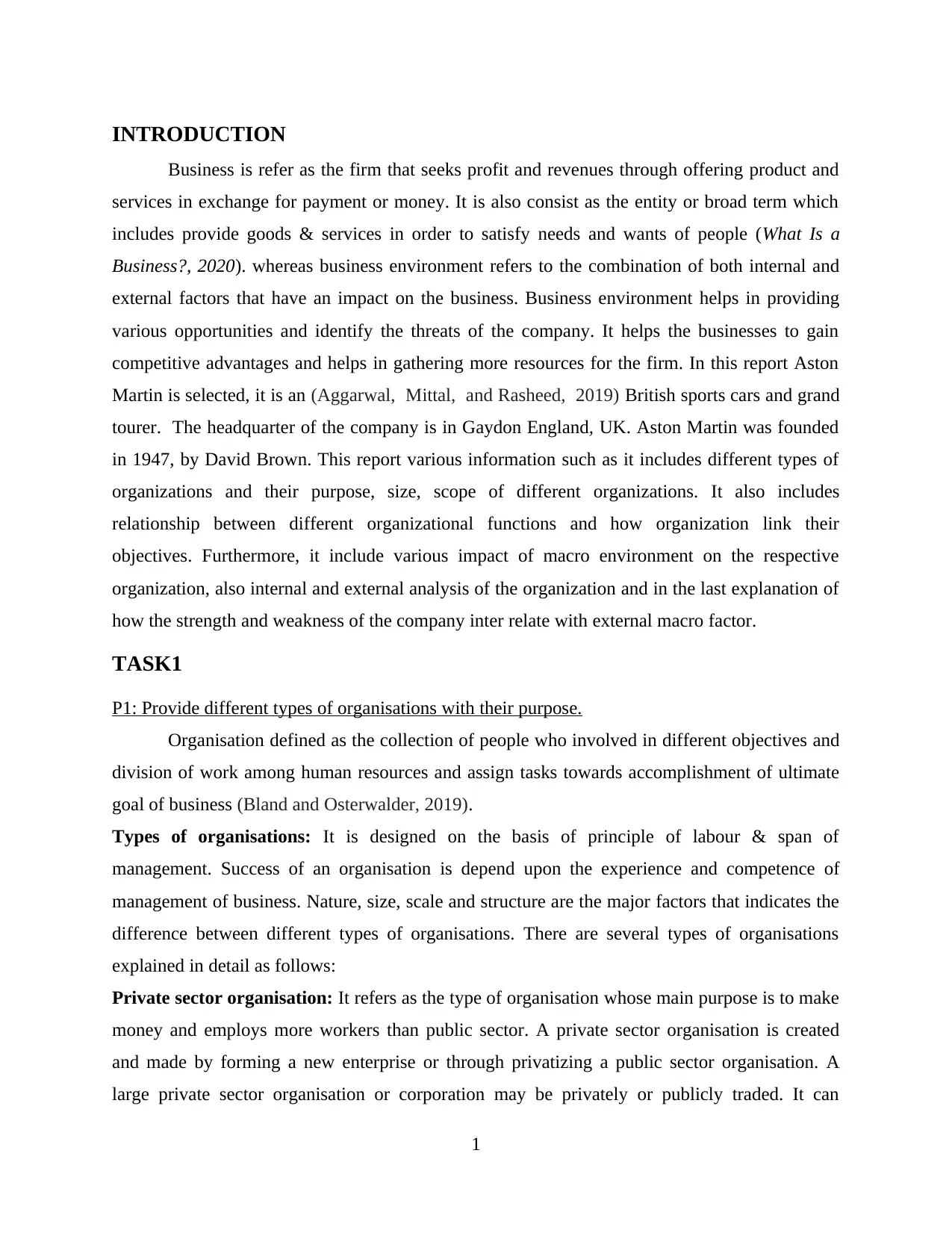
INTRODUCTION
Business is refer as the firm that seeks profit and revenues through offering product and
services in exchange for payment or money. It is also consist as the entity or broad term which
includes provide goods & services in order to satisfy needs and wants of people (What Is a
Business?, 2020). whereas business environment refers to the combination of both internal and
external factors that have an impact on the business. Business environment helps in providing
various opportunities and identify the threats of the company. It helps the businesses to gain
competitive advantages and helps in gathering more resources for the firm. In this report Aston
Martin is selected, it is an (Aggarwal, Mittal, and Rasheed, 2019) British sports cars and grand
tourer. The headquarter of the company is in Gaydon England, UK. Aston Martin was founded
in 1947, by David Brown. This report various information such as it includes different types of
organizations and their purpose, size, scope of different organizations. It also includes
relationship between different organizational functions and how organization link their
objectives. Furthermore, it include various impact of macro environment on the respective
organization, also internal and external analysis of the organization and in the last explanation of
how the strength and weakness of the company inter relate with external macro factor.
TASK1
P1: Provide different types of organisations with their purpose.
Organisation defined as the collection of people who involved in different objectives and
division of work among human resources and assign tasks towards accomplishment of ultimate
goal of business (Bland and Osterwalder, 2019).
Types of organisations: It is designed on the basis of principle of labour & span of
management. Success of an organisation is depend upon the experience and competence of
management of business. Nature, size, scale and structure are the major factors that indicates the
difference between different types of organisations. There are several types of organisations
explained in detail as follows:
Private sector organisation: It refers as the type of organisation whose main purpose is to make
money and employs more workers than public sector. A private sector organisation is created
and made by forming a new enterprise or through privatizing a public sector organisation. A
large private sector organisation or corporation may be privately or publicly traded. It can
1
Business is refer as the firm that seeks profit and revenues through offering product and
services in exchange for payment or money. It is also consist as the entity or broad term which
includes provide goods & services in order to satisfy needs and wants of people (What Is a
Business?, 2020). whereas business environment refers to the combination of both internal and
external factors that have an impact on the business. Business environment helps in providing
various opportunities and identify the threats of the company. It helps the businesses to gain
competitive advantages and helps in gathering more resources for the firm. In this report Aston
Martin is selected, it is an (Aggarwal, Mittal, and Rasheed, 2019) British sports cars and grand
tourer. The headquarter of the company is in Gaydon England, UK. Aston Martin was founded
in 1947, by David Brown. This report various information such as it includes different types of
organizations and their purpose, size, scope of different organizations. It also includes
relationship between different organizational functions and how organization link their
objectives. Furthermore, it include various impact of macro environment on the respective
organization, also internal and external analysis of the organization and in the last explanation of
how the strength and weakness of the company inter relate with external macro factor.
TASK1
P1: Provide different types of organisations with their purpose.
Organisation defined as the collection of people who involved in different objectives and
division of work among human resources and assign tasks towards accomplishment of ultimate
goal of business (Bland and Osterwalder, 2019).
Types of organisations: It is designed on the basis of principle of labour & span of
management. Success of an organisation is depend upon the experience and competence of
management of business. Nature, size, scale and structure are the major factors that indicates the
difference between different types of organisations. There are several types of organisations
explained in detail as follows:
Private sector organisation: It refers as the type of organisation whose main purpose is to make
money and employs more workers than public sector. A private sector organisation is created
and made by forming a new enterprise or through privatizing a public sector organisation. A
large private sector organisation or corporation may be privately or publicly traded. It can
1
Paraphrase This Document
Need a fresh take? Get an instant paraphrase of this document with our AI Paraphraser

collaborate with government run agencies in arrangements called public-private partnerships.
Private sector organisations plays significant role in both urban and economic development &
also offers job opportunities for social being (Brotspies and Weinstein, 2019). Thus it consist as
economy owned, managed and controlled by individuals & businesses seeking to generate profits
and revenues.
Purpose: The primary purpose of private sector business organisations is to make profits for
successful operation and growth of firm. It is the part of economy that is run by individuals and
companies for profit and is not controlled by state government. The private sector tends to make
up a larger share of economy in free market and capital based societies.
Legal structure
1. Sole productivity: It refers as the form of business organisations where it is owned,
controlled and managed by a single person who bears all the risks and enjoys profits
alone.2. Company: It is defined as an artificial person that exist only in the eyes of law having a
separate legal entity and common seal.
Public limited companies: It refers as the company listed on recognized stock exchange
and stocks that are traded publicly. Aston martin comes under this category of organisational
types that offers luxury sports cars with aim as to provide luxury comfort and ride for
customers.
Private limited companies: It is defined as the company which is neither listed on stock
exchange nor traded publicly.
3. Partnership: It consist as an association of two or more individuals who agrees to carry
business together and shares profits and risks collectively.
Public sector organisation: It refers as the organisations that are owned and operated by the
government which offers services for citizens. Public sector organisations provides a range of
governmental services includes infrastructure, education and transportation for public, health
care and military services. It varies as per country to country and depending upon legislation of
government. It plays significant role in delivery of public services especially health in
underdeveloped and low income countries.
Purpose: The main purpose of these types of organisations is to provide best service at any cost
and utilise resources to maximise productivity of country. Generally these type of firms focuses
2
Private sector organisations plays significant role in both urban and economic development &
also offers job opportunities for social being (Brotspies and Weinstein, 2019). Thus it consist as
economy owned, managed and controlled by individuals & businesses seeking to generate profits
and revenues.
Purpose: The primary purpose of private sector business organisations is to make profits for
successful operation and growth of firm. It is the part of economy that is run by individuals and
companies for profit and is not controlled by state government. The private sector tends to make
up a larger share of economy in free market and capital based societies.
Legal structure
1. Sole productivity: It refers as the form of business organisations where it is owned,
controlled and managed by a single person who bears all the risks and enjoys profits
alone.2. Company: It is defined as an artificial person that exist only in the eyes of law having a
separate legal entity and common seal.
Public limited companies: It refers as the company listed on recognized stock exchange
and stocks that are traded publicly. Aston martin comes under this category of organisational
types that offers luxury sports cars with aim as to provide luxury comfort and ride for
customers.
Private limited companies: It is defined as the company which is neither listed on stock
exchange nor traded publicly.
3. Partnership: It consist as an association of two or more individuals who agrees to carry
business together and shares profits and risks collectively.
Public sector organisation: It refers as the organisations that are owned and operated by the
government which offers services for citizens. Public sector organisations provides a range of
governmental services includes infrastructure, education and transportation for public, health
care and military services. It varies as per country to country and depending upon legislation of
government. It plays significant role in delivery of public services especially health in
underdeveloped and low income countries.
Purpose: The main purpose of these types of organisations is to provide best service at any cost
and utilise resources to maximise productivity of country. Generally these type of firms focuses
2
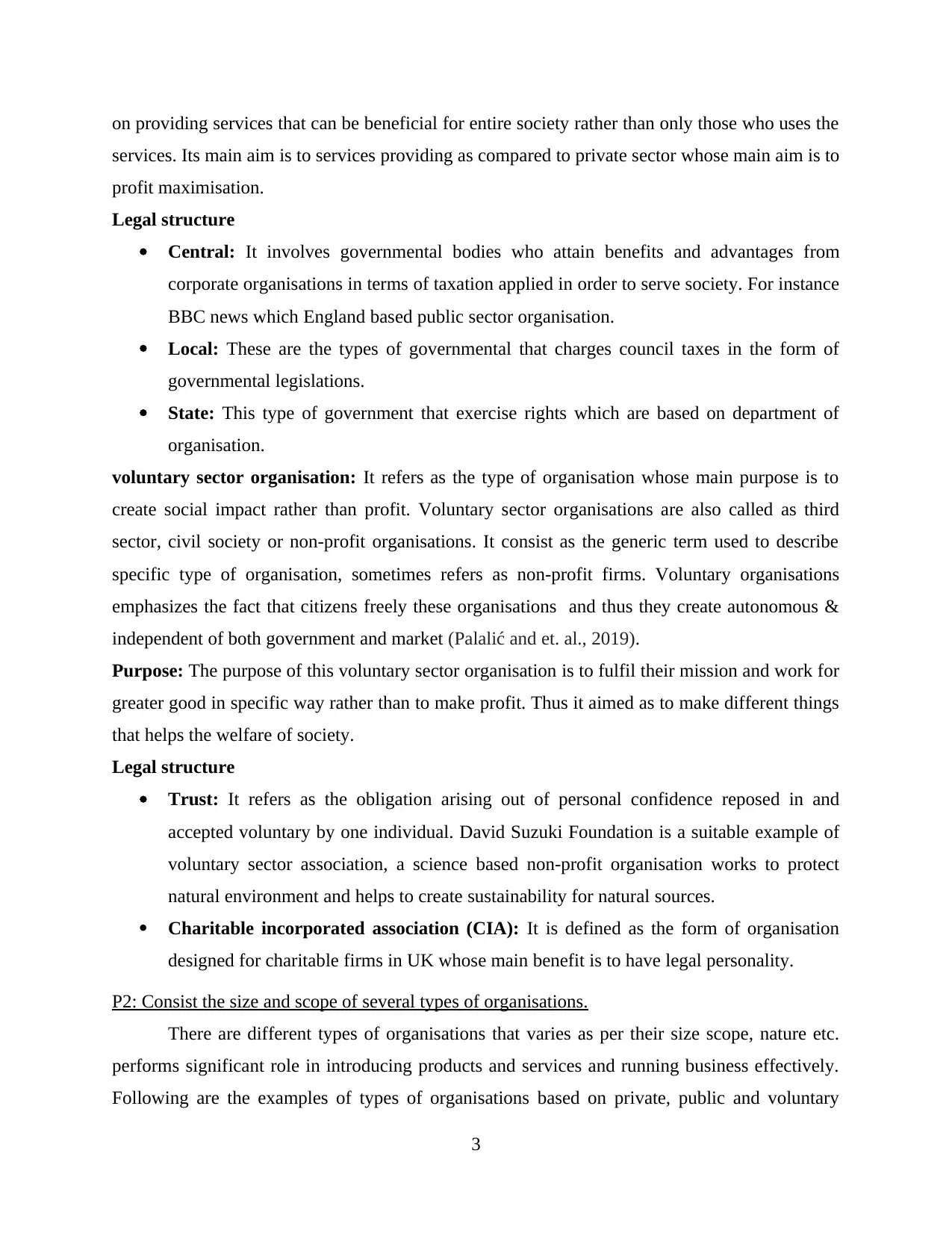
on providing services that can be beneficial for entire society rather than only those who uses the
services. Its main aim is to services providing as compared to private sector whose main aim is to
profit maximisation.
Legal structure
Central: It involves governmental bodies who attain benefits and advantages from
corporate organisations in terms of taxation applied in order to serve society. For instance
BBC news which England based public sector organisation.
Local: These are the types of governmental that charges council taxes in the form of
governmental legislations.
State: This type of government that exercise rights which are based on department of
organisation.
voluntary sector organisation: It refers as the type of organisation whose main purpose is to
create social impact rather than profit. Voluntary sector organisations are also called as third
sector, civil society or non-profit organisations. It consist as the generic term used to describe
specific type of organisation, sometimes refers as non-profit firms. Voluntary organisations
emphasizes the fact that citizens freely these organisations and thus they create autonomous &
independent of both government and market (Palalić and et. al., 2019).
Purpose: The purpose of this voluntary sector organisation is to fulfil their mission and work for
greater good in specific way rather than to make profit. Thus it aimed as to make different things
that helps the welfare of society.
Legal structure
Trust: It refers as the obligation arising out of personal confidence reposed in and
accepted voluntary by one individual. David Suzuki Foundation is a suitable example of
voluntary sector association, a science based non-profit organisation works to protect
natural environment and helps to create sustainability for natural sources.
Charitable incorporated association (CIA): It is defined as the form of organisation
designed for charitable firms in UK whose main benefit is to have legal personality.
P2: Consist the size and scope of several types of organisations.
There are different types of organisations that varies as per their size scope, nature etc.
performs significant role in introducing products and services and running business effectively.
Following are the examples of types of organisations based on private, public and voluntary
3
services. Its main aim is to services providing as compared to private sector whose main aim is to
profit maximisation.
Legal structure
Central: It involves governmental bodies who attain benefits and advantages from
corporate organisations in terms of taxation applied in order to serve society. For instance
BBC news which England based public sector organisation.
Local: These are the types of governmental that charges council taxes in the form of
governmental legislations.
State: This type of government that exercise rights which are based on department of
organisation.
voluntary sector organisation: It refers as the type of organisation whose main purpose is to
create social impact rather than profit. Voluntary sector organisations are also called as third
sector, civil society or non-profit organisations. It consist as the generic term used to describe
specific type of organisation, sometimes refers as non-profit firms. Voluntary organisations
emphasizes the fact that citizens freely these organisations and thus they create autonomous &
independent of both government and market (Palalić and et. al., 2019).
Purpose: The purpose of this voluntary sector organisation is to fulfil their mission and work for
greater good in specific way rather than to make profit. Thus it aimed as to make different things
that helps the welfare of society.
Legal structure
Trust: It refers as the obligation arising out of personal confidence reposed in and
accepted voluntary by one individual. David Suzuki Foundation is a suitable example of
voluntary sector association, a science based non-profit organisation works to protect
natural environment and helps to create sustainability for natural sources.
Charitable incorporated association (CIA): It is defined as the form of organisation
designed for charitable firms in UK whose main benefit is to have legal personality.
P2: Consist the size and scope of several types of organisations.
There are different types of organisations that varies as per their size scope, nature etc.
performs significant role in introducing products and services and running business effectively.
Following are the examples of types of organisations based on private, public and voluntary
3
⊘ This is a preview!⊘
Do you want full access?
Subscribe today to unlock all pages.

Trusted by 1+ million students worldwide
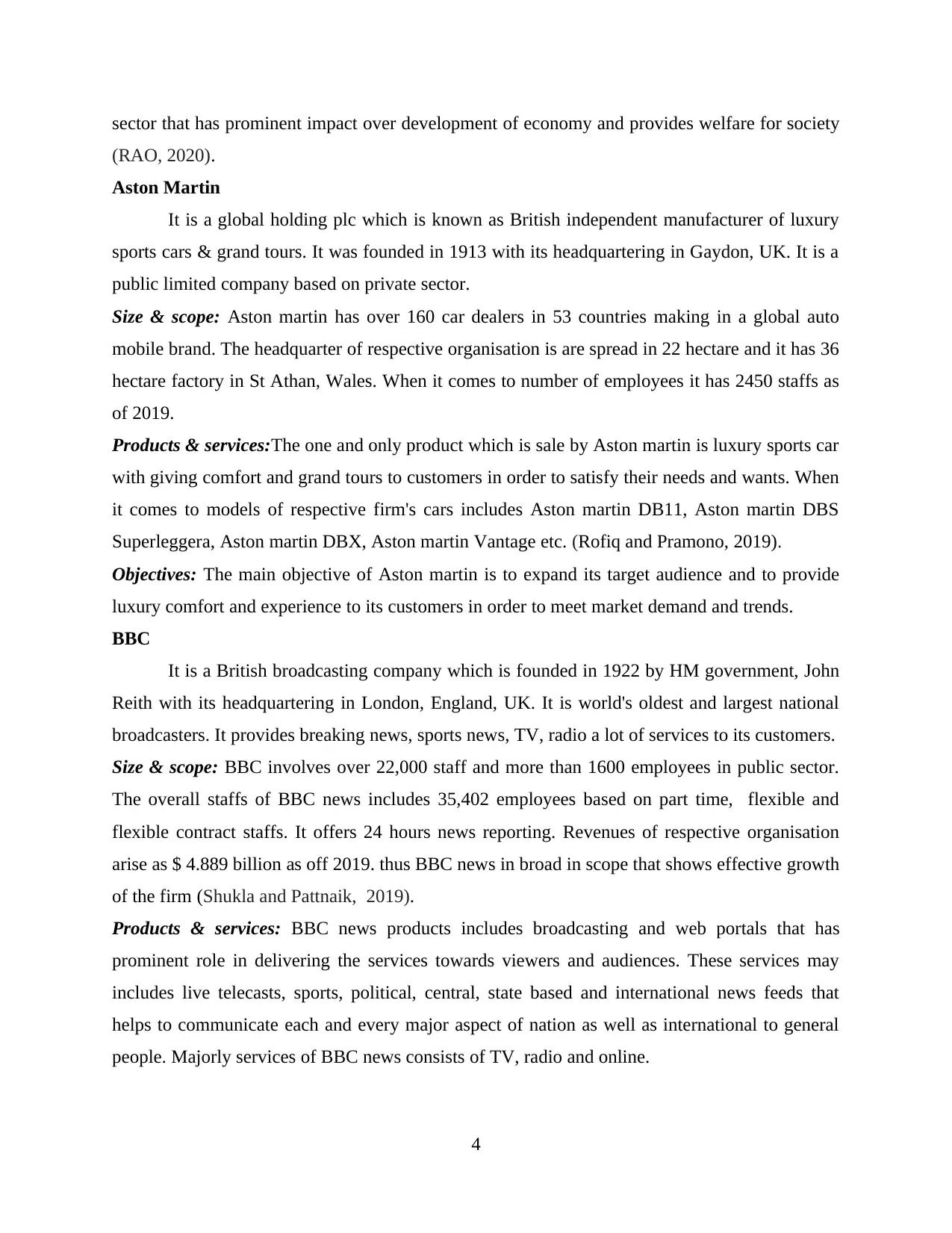
sector that has prominent impact over development of economy and provides welfare for society
(RAO, 2020).
Aston Martin
It is a global holding plc which is known as British independent manufacturer of luxury
sports cars & grand tours. It was founded in 1913 with its headquartering in Gaydon, UK. It is a
public limited company based on private sector.
Size & scope: Aston martin has over 160 car dealers in 53 countries making in a global auto
mobile brand. The headquarter of respective organisation is are spread in 22 hectare and it has 36
hectare factory in St Athan, Wales. When it comes to number of employees it has 2450 staffs as
of 2019.
Products & services:The one and only product which is sale by Aston martin is luxury sports car
with giving comfort and grand tours to customers in order to satisfy their needs and wants. When
it comes to models of respective firm's cars includes Aston martin DB11, Aston martin DBS
Superleggera, Aston martin DBX, Aston martin Vantage etc. (Rofiq and Pramono, 2019).
Objectives: The main objective of Aston martin is to expand its target audience and to provide
luxury comfort and experience to its customers in order to meet market demand and trends.
BBC
It is a British broadcasting company which is founded in 1922 by HM government, John
Reith with its headquartering in London, England, UK. It is world's oldest and largest national
broadcasters. It provides breaking news, sports news, TV, radio a lot of services to its customers.
Size & scope: BBC involves over 22,000 staff and more than 1600 employees in public sector.
The overall staffs of BBC news includes 35,402 employees based on part time, flexible and
flexible contract staffs. It offers 24 hours news reporting. Revenues of respective organisation
arise as $ 4.889 billion as off 2019. thus BBC news in broad in scope that shows effective growth
of the firm (Shukla and Pattnaik, 2019).
Products & services: BBC news products includes broadcasting and web portals that has
prominent role in delivering the services towards viewers and audiences. These services may
includes live telecasts, sports, political, central, state based and international news feeds that
helps to communicate each and every major aspect of nation as well as international to general
people. Majorly services of BBC news consists of TV, radio and online.
4
(RAO, 2020).
Aston Martin
It is a global holding plc which is known as British independent manufacturer of luxury
sports cars & grand tours. It was founded in 1913 with its headquartering in Gaydon, UK. It is a
public limited company based on private sector.
Size & scope: Aston martin has over 160 car dealers in 53 countries making in a global auto
mobile brand. The headquarter of respective organisation is are spread in 22 hectare and it has 36
hectare factory in St Athan, Wales. When it comes to number of employees it has 2450 staffs as
of 2019.
Products & services:The one and only product which is sale by Aston martin is luxury sports car
with giving comfort and grand tours to customers in order to satisfy their needs and wants. When
it comes to models of respective firm's cars includes Aston martin DB11, Aston martin DBS
Superleggera, Aston martin DBX, Aston martin Vantage etc. (Rofiq and Pramono, 2019).
Objectives: The main objective of Aston martin is to expand its target audience and to provide
luxury comfort and experience to its customers in order to meet market demand and trends.
BBC
It is a British broadcasting company which is founded in 1922 by HM government, John
Reith with its headquartering in London, England, UK. It is world's oldest and largest national
broadcasters. It provides breaking news, sports news, TV, radio a lot of services to its customers.
Size & scope: BBC involves over 22,000 staff and more than 1600 employees in public sector.
The overall staffs of BBC news includes 35,402 employees based on part time, flexible and
flexible contract staffs. It offers 24 hours news reporting. Revenues of respective organisation
arise as $ 4.889 billion as off 2019. thus BBC news in broad in scope that shows effective growth
of the firm (Shukla and Pattnaik, 2019).
Products & services: BBC news products includes broadcasting and web portals that has
prominent role in delivering the services towards viewers and audiences. These services may
includes live telecasts, sports, political, central, state based and international news feeds that
helps to communicate each and every major aspect of nation as well as international to general
people. Majorly services of BBC news consists of TV, radio and online.
4
Paraphrase This Document
Need a fresh take? Get an instant paraphrase of this document with our AI Paraphraser
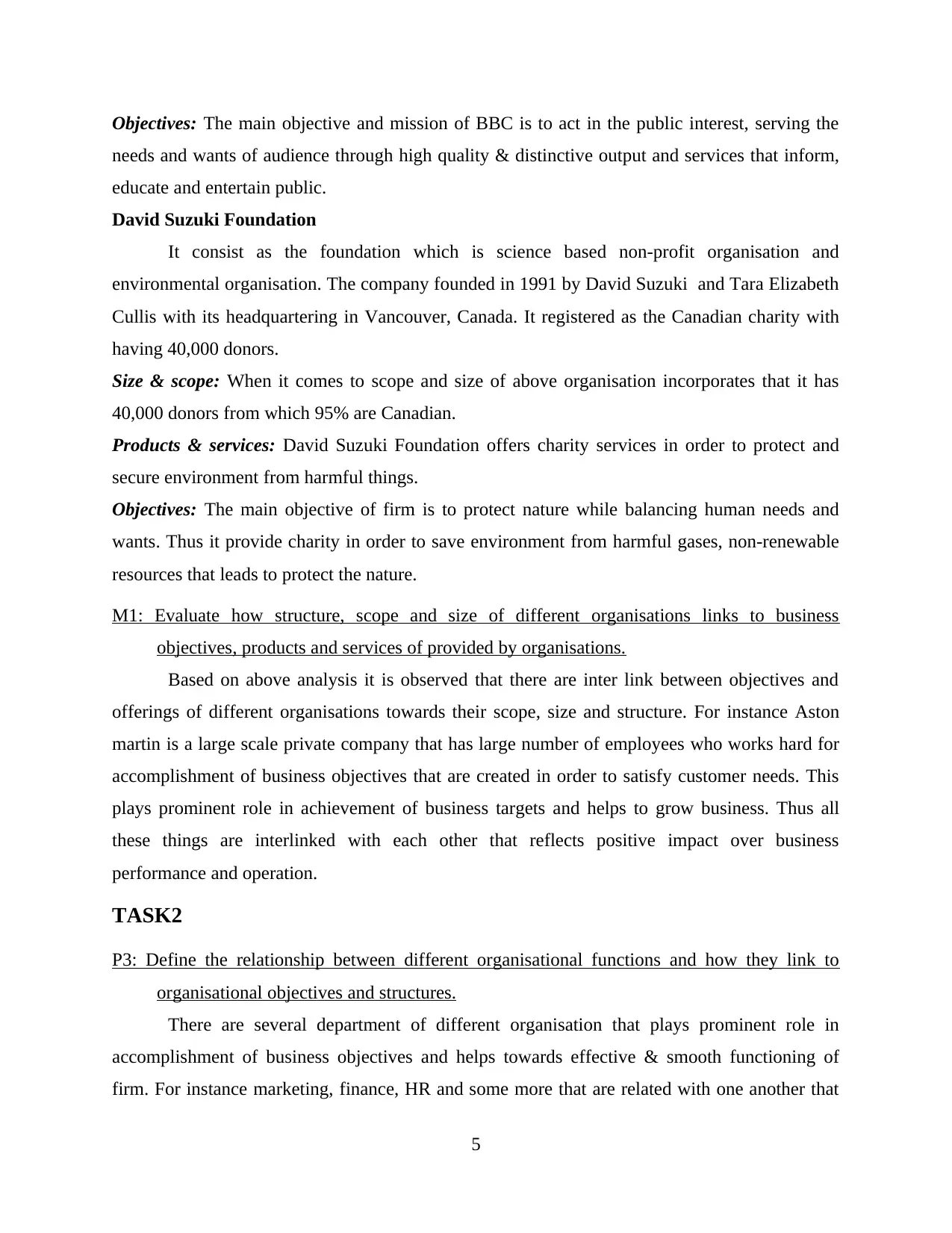
Objectives: The main objective and mission of BBC is to act in the public interest, serving the
needs and wants of audience through high quality & distinctive output and services that inform,
educate and entertain public.
David Suzuki Foundation
It consist as the foundation which is science based non-profit organisation and
environmental organisation. The company founded in 1991 by David Suzuki and Tara Elizabeth
Cullis with its headquartering in Vancouver, Canada. It registered as the Canadian charity with
having 40,000 donors.
Size & scope: When it comes to scope and size of above organisation incorporates that it has
40,000 donors from which 95% are Canadian.
Products & services: David Suzuki Foundation offers charity services in order to protect and
secure environment from harmful things.
Objectives: The main objective of firm is to protect nature while balancing human needs and
wants. Thus it provide charity in order to save environment from harmful gases, non-renewable
resources that leads to protect the nature.
M1: Evaluate how structure, scope and size of different organisations links to business
objectives, products and services of provided by organisations.
Based on above analysis it is observed that there are inter link between objectives and
offerings of different organisations towards their scope, size and structure. For instance Aston
martin is a large scale private company that has large number of employees who works hard for
accomplishment of business objectives that are created in order to satisfy customer needs. This
plays prominent role in achievement of business targets and helps to grow business. Thus all
these things are interlinked with each other that reflects positive impact over business
performance and operation.
TASK2
P3: Define the relationship between different organisational functions and how they link to
organisational objectives and structures.
There are several department of different organisation that plays prominent role in
accomplishment of business objectives and helps towards effective & smooth functioning of
firm. For instance marketing, finance, HR and some more that are related with one another that
5
needs and wants of audience through high quality & distinctive output and services that inform,
educate and entertain public.
David Suzuki Foundation
It consist as the foundation which is science based non-profit organisation and
environmental organisation. The company founded in 1991 by David Suzuki and Tara Elizabeth
Cullis with its headquartering in Vancouver, Canada. It registered as the Canadian charity with
having 40,000 donors.
Size & scope: When it comes to scope and size of above organisation incorporates that it has
40,000 donors from which 95% are Canadian.
Products & services: David Suzuki Foundation offers charity services in order to protect and
secure environment from harmful things.
Objectives: The main objective of firm is to protect nature while balancing human needs and
wants. Thus it provide charity in order to save environment from harmful gases, non-renewable
resources that leads to protect the nature.
M1: Evaluate how structure, scope and size of different organisations links to business
objectives, products and services of provided by organisations.
Based on above analysis it is observed that there are inter link between objectives and
offerings of different organisations towards their scope, size and structure. For instance Aston
martin is a large scale private company that has large number of employees who works hard for
accomplishment of business objectives that are created in order to satisfy customer needs. This
plays prominent role in achievement of business targets and helps to grow business. Thus all
these things are interlinked with each other that reflects positive impact over business
performance and operation.
TASK2
P3: Define the relationship between different organisational functions and how they link to
organisational objectives and structures.
There are several department of different organisation that plays prominent role in
accomplishment of business objectives and helps towards effective & smooth functioning of
firm. For instance marketing, finance, HR and some more that are related with one another that
5

supports targets achievements. Aston martin has different departments that has prominent role in
successful accomplishment of business objectives (Vlados and Chatzinikolaou, 2019).
Relationship of these departments are explained as follows:
Marketing & Human resource department: Marketing department of respective firm invested
huge money in analysing needs and wants of target market in order to make effective goods and
promote them at a broad place so as to attract more customers. Human resource is the department
that plays significant role in conducting surveys and communicating or displaying goods and
services in front of customers so as to satisfy their needs in effective manner. Thus it reflects as
interrelationship between both the department that added a value towards attainment of business
goals.
Finance & IT department: In context of respective organisation the information & technology
department is responsible for technological advancement of its products and services that has
prominent impact over brand expansion as well as profit maximisation. It take constant
initiatives towards use of new and advanced technology. Finance department plays significant
function and role in operating significant changes requires in terms of technological
advancement for business through allocating funds. R&D is responsible for adopting new and
advanced technology and finance department allocates funds for successful implementation of
these technologies.
Operation & RD department: Aston marting has effective research and development
department that plays significant function in analysing market needs, trends and helps to analyse
the need of development of new products in order to meet market demand. Then operation
department is responsible to make and develop products and outputs as per the analysis of R&D
department. This is important in order to identify market demand & latest trends and then satisfy
the needs of customers that leads to profit maximisation of firm as well as increasing sales
revenues of business (Cepel and et. al., 2019).
M2: Evaluate the benefits and drawbacks of interrelationship between organisational functions
and their impact on organisational structure.
On the basis of above analysis it is concluded that there are some benefits of
interrelationship between above department including it helps in smooth functioning of business
without any interruption. All department performs their jobs well and helps each other in provide
needed information and knowledge. It develop mutual cooperation and coordination between
6
successful accomplishment of business objectives (Vlados and Chatzinikolaou, 2019).
Relationship of these departments are explained as follows:
Marketing & Human resource department: Marketing department of respective firm invested
huge money in analysing needs and wants of target market in order to make effective goods and
promote them at a broad place so as to attract more customers. Human resource is the department
that plays significant role in conducting surveys and communicating or displaying goods and
services in front of customers so as to satisfy their needs in effective manner. Thus it reflects as
interrelationship between both the department that added a value towards attainment of business
goals.
Finance & IT department: In context of respective organisation the information & technology
department is responsible for technological advancement of its products and services that has
prominent impact over brand expansion as well as profit maximisation. It take constant
initiatives towards use of new and advanced technology. Finance department plays significant
function and role in operating significant changes requires in terms of technological
advancement for business through allocating funds. R&D is responsible for adopting new and
advanced technology and finance department allocates funds for successful implementation of
these technologies.
Operation & RD department: Aston marting has effective research and development
department that plays significant function in analysing market needs, trends and helps to analyse
the need of development of new products in order to meet market demand. Then operation
department is responsible to make and develop products and outputs as per the analysis of R&D
department. This is important in order to identify market demand & latest trends and then satisfy
the needs of customers that leads to profit maximisation of firm as well as increasing sales
revenues of business (Cepel and et. al., 2019).
M2: Evaluate the benefits and drawbacks of interrelationship between organisational functions
and their impact on organisational structure.
On the basis of above analysis it is concluded that there are some benefits of
interrelationship between above department including it helps in smooth functioning of business
without any interruption. All department performs their jobs well and helps each other in provide
needed information and knowledge. It develop mutual cooperation and coordination between
6
⊘ This is a preview!⊘
Do you want full access?
Subscribe today to unlock all pages.

Trusted by 1+ million students worldwide
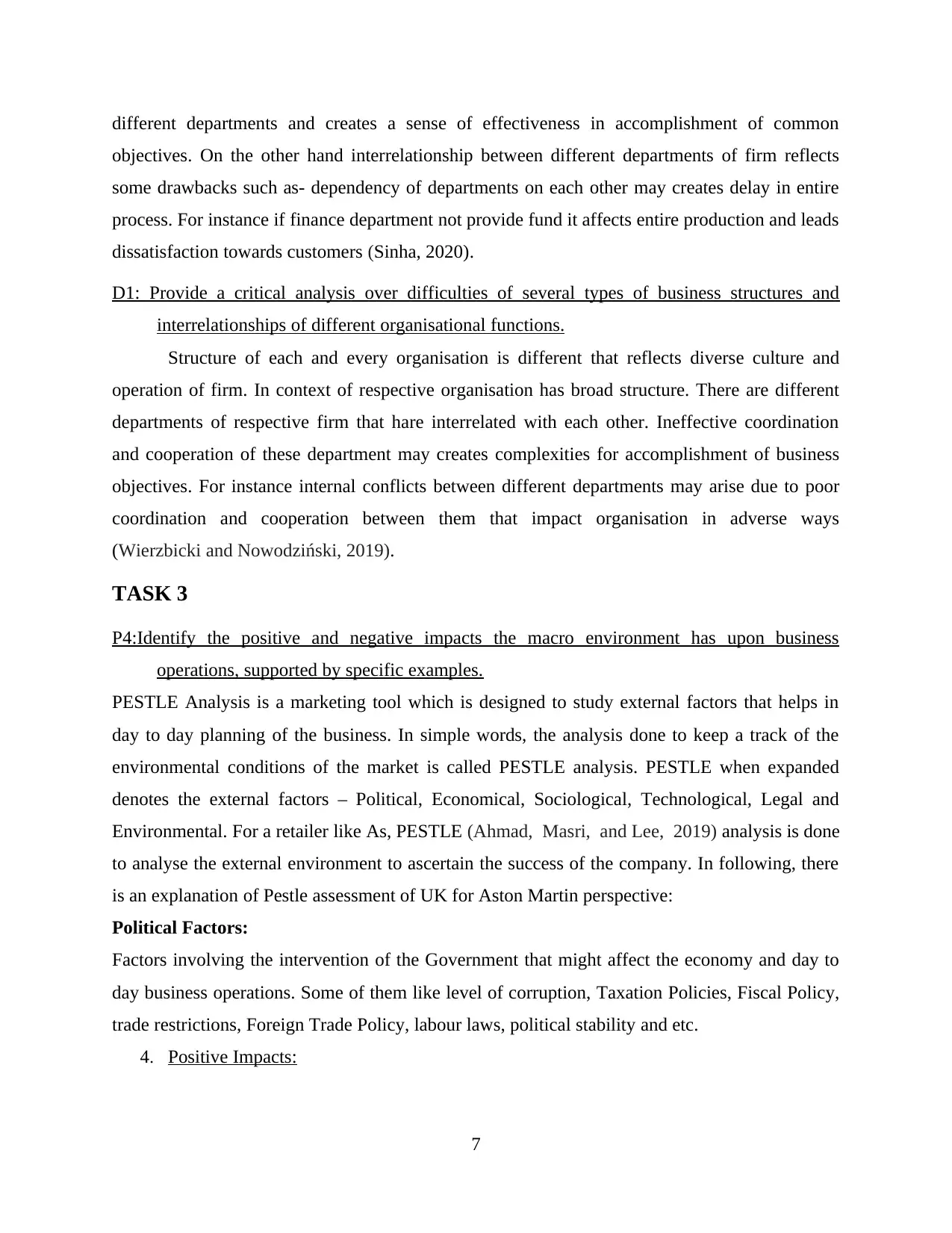
different departments and creates a sense of effectiveness in accomplishment of common
objectives. On the other hand interrelationship between different departments of firm reflects
some drawbacks such as- dependency of departments on each other may creates delay in entire
process. For instance if finance department not provide fund it affects entire production and leads
dissatisfaction towards customers (Sinha, 2020).
D1: Provide a critical analysis over difficulties of several types of business structures and
interrelationships of different organisational functions.
Structure of each and every organisation is different that reflects diverse culture and
operation of firm. In context of respective organisation has broad structure. There are different
departments of respective firm that hare interrelated with each other. Ineffective coordination
and cooperation of these department may creates complexities for accomplishment of business
objectives. For instance internal conflicts between different departments may arise due to poor
coordination and cooperation between them that impact organisation in adverse ways
(Wierzbicki and Nowodziński, 2019).
TASK 3
P4:Identify the positive and negative impacts the macro environment has upon business
operations, supported by specific examples.
PESTLE Analysis is a marketing tool which is designed to study external factors that helps in
day to day planning of the business. In simple words, the analysis done to keep a track of the
environmental conditions of the market is called PESTLE analysis. PESTLE when expanded
denotes the external factors – Political, Economical, Sociological, Technological, Legal and
Environmental. For a retailer like As, PESTLE (Ahmad, Masri, and Lee, 2019) analysis is done
to analyse the external environment to ascertain the success of the company. In following, there
is an explanation of Pestle assessment of UK for Aston Martin perspective:
Political Factors:
Factors involving the intervention of the Government that might affect the economy and day to
day business operations. Some of them like level of corruption, Taxation Policies, Fiscal Policy,
trade restrictions, Foreign Trade Policy, labour laws, political stability and etc.
4. Positive Impacts:
7
objectives. On the other hand interrelationship between different departments of firm reflects
some drawbacks such as- dependency of departments on each other may creates delay in entire
process. For instance if finance department not provide fund it affects entire production and leads
dissatisfaction towards customers (Sinha, 2020).
D1: Provide a critical analysis over difficulties of several types of business structures and
interrelationships of different organisational functions.
Structure of each and every organisation is different that reflects diverse culture and
operation of firm. In context of respective organisation has broad structure. There are different
departments of respective firm that hare interrelated with each other. Ineffective coordination
and cooperation of these department may creates complexities for accomplishment of business
objectives. For instance internal conflicts between different departments may arise due to poor
coordination and cooperation between them that impact organisation in adverse ways
(Wierzbicki and Nowodziński, 2019).
TASK 3
P4:Identify the positive and negative impacts the macro environment has upon business
operations, supported by specific examples.
PESTLE Analysis is a marketing tool which is designed to study external factors that helps in
day to day planning of the business. In simple words, the analysis done to keep a track of the
environmental conditions of the market is called PESTLE analysis. PESTLE when expanded
denotes the external factors – Political, Economical, Sociological, Technological, Legal and
Environmental. For a retailer like As, PESTLE (Ahmad, Masri, and Lee, 2019) analysis is done
to analyse the external environment to ascertain the success of the company. In following, there
is an explanation of Pestle assessment of UK for Aston Martin perspective:
Political Factors:
Factors involving the intervention of the Government that might affect the economy and day to
day business operations. Some of them like level of corruption, Taxation Policies, Fiscal Policy,
trade restrictions, Foreign Trade Policy, labour laws, political stability and etc.
4. Positive Impacts:
7
Paraphrase This Document
Need a fresh take? Get an instant paraphrase of this document with our AI Paraphraser
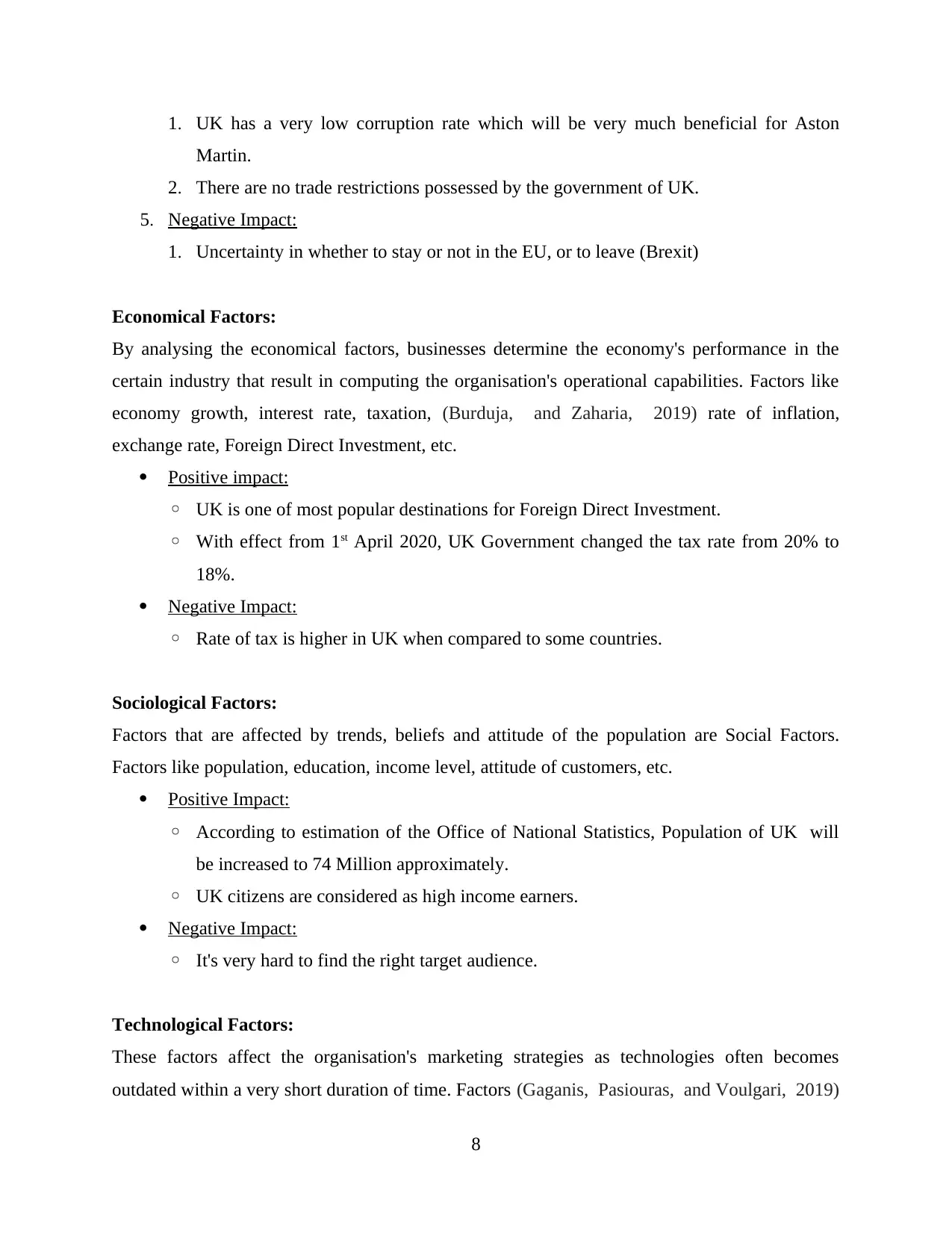
1. UK has a very low corruption rate which will be very much beneficial for Aston
Martin.
2. There are no trade restrictions possessed by the government of UK.
5. Negative Impact:
1. Uncertainty in whether to stay or not in the EU, or to leave (Brexit)
Economical Factors:
By analysing the economical factors, businesses determine the economy's performance in the
certain industry that result in computing the organisation's operational capabilities. Factors like
economy growth, interest rate, taxation, (Burduja, and Zaharia, 2019) rate of inflation,
exchange rate, Foreign Direct Investment, etc.
Positive impact:
◦ UK is one of most popular destinations for Foreign Direct Investment.
◦ With effect from 1st April 2020, UK Government changed the tax rate from 20% to
18%.
Negative Impact:
◦ Rate of tax is higher in UK when compared to some countries.
Sociological Factors:
Factors that are affected by trends, beliefs and attitude of the population are Social Factors.
Factors like population, education, income level, attitude of customers, etc.
Positive Impact:
◦ According to estimation of the Office of National Statistics, Population of UK will
be increased to 74 Million approximately.
◦ UK citizens are considered as high income earners.
Negative Impact:
◦ It's very hard to find the right target audience.
Technological Factors:
These factors affect the organisation's marketing strategies as technologies often becomes
outdated within a very short duration of time. Factors (Gaganis, Pasiouras, and Voulgari, 2019)
8
Martin.
2. There are no trade restrictions possessed by the government of UK.
5. Negative Impact:
1. Uncertainty in whether to stay or not in the EU, or to leave (Brexit)
Economical Factors:
By analysing the economical factors, businesses determine the economy's performance in the
certain industry that result in computing the organisation's operational capabilities. Factors like
economy growth, interest rate, taxation, (Burduja, and Zaharia, 2019) rate of inflation,
exchange rate, Foreign Direct Investment, etc.
Positive impact:
◦ UK is one of most popular destinations for Foreign Direct Investment.
◦ With effect from 1st April 2020, UK Government changed the tax rate from 20% to
18%.
Negative Impact:
◦ Rate of tax is higher in UK when compared to some countries.
Sociological Factors:
Factors that are affected by trends, beliefs and attitude of the population are Social Factors.
Factors like population, education, income level, attitude of customers, etc.
Positive Impact:
◦ According to estimation of the Office of National Statistics, Population of UK will
be increased to 74 Million approximately.
◦ UK citizens are considered as high income earners.
Negative Impact:
◦ It's very hard to find the right target audience.
Technological Factors:
These factors affect the organisation's marketing strategies as technologies often becomes
outdated within a very short duration of time. Factors (Gaganis, Pasiouras, and Voulgari, 2019)
8
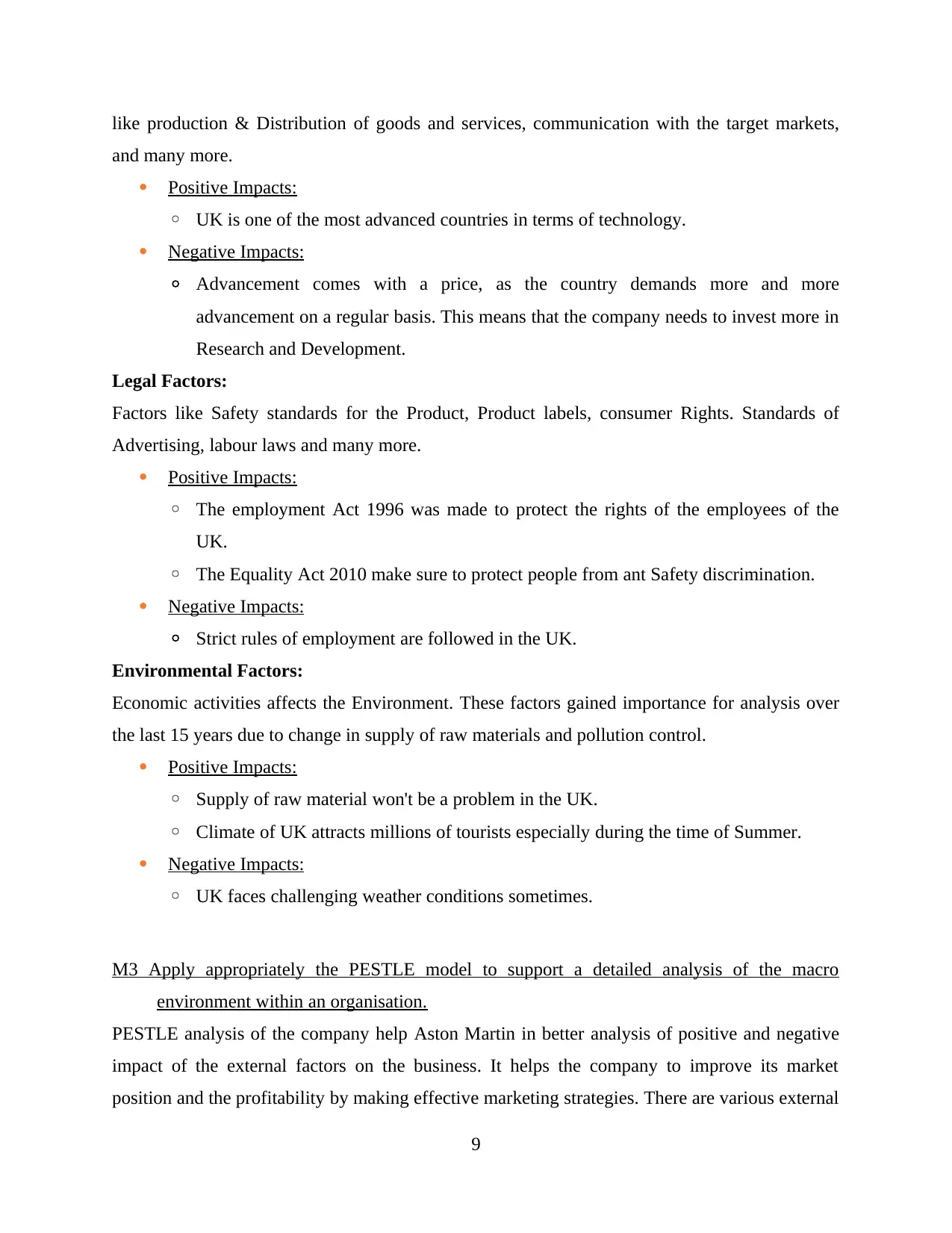
like production & Distribution of goods and services, communication with the target markets,
and many more.
Positive Impacts:
◦ UK is one of the most advanced countries in terms of technology.
Negative Impacts:
◦ Advancement comes with a price, as the country demands more and more
advancement on a regular basis. This means that the company needs to invest more in
Research and Development.
Legal Factors:
Factors like Safety standards for the Product, Product labels, consumer Rights. Standards of
Advertising, labour laws and many more.
Positive Impacts:
◦ The employment Act 1996 was made to protect the rights of the employees of the
UK.
◦ The Equality Act 2010 make sure to protect people from ant Safety discrimination.
Negative Impacts:
◦ Strict rules of employment are followed in the UK.
Environmental Factors:
Economic activities affects the Environment. These factors gained importance for analysis over
the last 15 years due to change in supply of raw materials and pollution control.
Positive Impacts:
◦ Supply of raw material won't be a problem in the UK.
◦ Climate of UK attracts millions of tourists especially during the time of Summer.
Negative Impacts:
◦ UK faces challenging weather conditions sometimes.
M3 Apply appropriately the PESTLE model to support a detailed analysis of the macro
environment within an organisation.
PESTLE analysis of the company help Aston Martin in better analysis of positive and negative
impact of the external factors on the business. It helps the company to improve its market
position and the profitability by making effective marketing strategies. There are various external
9
and many more.
Positive Impacts:
◦ UK is one of the most advanced countries in terms of technology.
Negative Impacts:
◦ Advancement comes with a price, as the country demands more and more
advancement on a regular basis. This means that the company needs to invest more in
Research and Development.
Legal Factors:
Factors like Safety standards for the Product, Product labels, consumer Rights. Standards of
Advertising, labour laws and many more.
Positive Impacts:
◦ The employment Act 1996 was made to protect the rights of the employees of the
UK.
◦ The Equality Act 2010 make sure to protect people from ant Safety discrimination.
Negative Impacts:
◦ Strict rules of employment are followed in the UK.
Environmental Factors:
Economic activities affects the Environment. These factors gained importance for analysis over
the last 15 years due to change in supply of raw materials and pollution control.
Positive Impacts:
◦ Supply of raw material won't be a problem in the UK.
◦ Climate of UK attracts millions of tourists especially during the time of Summer.
Negative Impacts:
◦ UK faces challenging weather conditions sometimes.
M3 Apply appropriately the PESTLE model to support a detailed analysis of the macro
environment within an organisation.
PESTLE analysis of the company help Aston Martin in better analysis of positive and negative
impact of the external factors on the business. It helps the company to improve its market
position and the profitability by making effective marketing strategies. There are various external
9
⊘ This is a preview!⊘
Do you want full access?
Subscribe today to unlock all pages.

Trusted by 1+ million students worldwide
1 out of 20
Related Documents
Your All-in-One AI-Powered Toolkit for Academic Success.
+13062052269
info@desklib.com
Available 24*7 on WhatsApp / Email
![[object Object]](/_next/static/media/star-bottom.7253800d.svg)
Unlock your academic potential
Copyright © 2020–2025 A2Z Services. All Rights Reserved. Developed and managed by ZUCOL.


